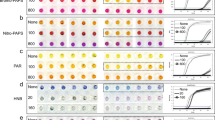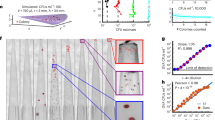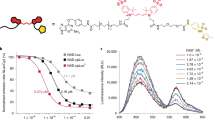Abstract
We describe a step-by-step protocol for measuring the stable products of the nitric oxide (NO) pathway: nitrite, nitrite plus nitrate and nitrate. This described protocol is easy to apply and is about 50 times more sensitive than the commonly used Griess reaction or commercially available assay kits based on the Griess reaction. It also allows the study of minimal changes in the NO pathway. With this method, it takes about 3 h to analyze the above-mentioned stable products in culture supernatants or in various body fluids, and the method has a sensitive linear range of 0.02–10.0 μM. This restricted linear range suggests that the technique is useful for studying small changes of nitrite and nitrate, rather than for routine diagnostic measurements.
This is a preview of subscription content, access via your institution
Access options
Subscribe to this journal
Receive 12 print issues and online access
$259.00 per year
only $21.58 per issue
Buy this article
- Purchase on Springer Link
- Instant access to full article PDF
Prices may be subject to local taxes which are calculated during checkout


Similar content being viewed by others
References
Bian, K. & Murad, F. Nitric oxide (NO)—biogeneration, regulation, and relevance to human diseases. Front. Biosci. 8, d264–d278 (2003).
Gladwin, M.T. et al. Nitrite as a vascular endocrine nitric oxide reservoir that contributes to hypoxic signaling, cytoprotection and vasodilation. Am. J. Physiol. Heart Circ. Physiol. 291, H2026–H2035 (2006).
Nathan, C. Inducible nitric oxide synthase: what difference does it make? J. Clin. Invest. 100, 2417–2423 (1997).
Hobbs, A.J., Higgs, A. & Moncada, S. Inhibition of nitric oxide synthase as a potential therapeutic target. Annu. Rev. Pharmacol. Toxicol. 39, 191–220 (1999).
Levy, R.M., Prince, J.M. & Billiar, T.R. Nitric oxide: a clinical primer. Crit. Care Med. 33, 492–495 (2005).
Nitric oxide detection, mitochondria and cell functions, and peroxynitrite reactions. In Methods in Enzymology, Nitric Oxide, Part D, Vol. 359 (eds. Cadenas, E. & Packer, L.) (Academic Press, San Diego, CA, USA 2002).
Griess, P. Bemerkung zu der Abhandlung der HH Weseley und Benedikt: “Über einige Azoverbindungen”. Ber. Dtsch. Chem. Ges. 12, 426–428 (1879).
Green, L.C. et al. Analysis of nitrate, nitrite, and [15N] nitrate in biological fluids. Anal. Biochem. 126, 131–138 (1982).
Gilliam, M.B., Sherman, M.P., Griscavage, J.M. & Ignarro, L.J. A spectrophotometric assay for nitrate using NADPH oxidation by Aspergillus nitrate reductase. Anal. Biochem. 212, 359–365 (1993).
Misko, T.P., Schilling, R.J., Salvemini, D., Moore, W.M. & Curie, M.G. A fluorometric assay for the measurement of nitrite in biological samples. Anal. Biochem. 214, 11–16 (1993).
Pelletier, M.M. et al. The measurement of blood and plasma nitrite by chemiluminescence: pitfalls and solutions. Free Radic. Biol. Med. 41, 541–548 (2006).
Miles, A.M., Chen, Y., Owens, M.W. & Grisham, M.B. Fluorometric determination of nitric oxide. Methods 7, 40–47 (1995).
Nussler, A.K. et al. Stimulation of the nitric oxide synthase pathway in human hepatocytes by cytokines and endotoxin. J. Exp. Med. 176, 261–264 (1992).
Li, H., Meininger, C.J. & Wu, G. Rapid determination of nitrite by reversed-phase high-performance liquid chromatography with fluorescence detection. J. Chromatogr. B. Biomed. Sci. Appl. 746, 199–207 (2000).
Marzinzig, M. et al. Improved methods to measure end products of nitric oxide in biological fluids: nitrite, nitrate, and S-nitrosothiols. Nitric Oxide 1, 177–189 (1997).
Kremsner, P.G. et al. High plasma levels of nitrogen oxides are associated with severe disease and correlate with rapid parasitological and clinical cure in Plasmodium falciparum malaria. Trans. R. Soc. Trop. Med. Hyg. 90, 44–47 (1996).
Nathan, C. Role of iNOS in human host defense. Science 312, 1874–1875 (2006).
Acknowledgements
The present work was partially supported by the Federal Ministry of Research (BMBF 0313079A to N.C.N.).
Author information
Authors and Affiliations
Corresponding author
Ethics declarations
Competing interests
The authors declare no competing financial interests.
Rights and permissions
About this article
Cite this article
Nussler, A., Glanemann, M., Schirmeier, A. et al. Fluorometric measurement of nitrite/nitrate by 2,3-diaminonaphthalene. Nat Protoc 1, 2223–2226 (2006). https://doi.org/10.1038/nprot.2006.341
Published:
Issue Date:
DOI: https://doi.org/10.1038/nprot.2006.341
This article is cited by
-
Isolation and characterization of the hydrophilic BNI compound, 6-methoxy-2(3H)-benzoxazolone (MBOA), from maize roots
Plant and Soil (2023)
-
Exogenous hydrogen sulfide alleviates surgery-induced neuroinflammatory cognitive impairment in adult mice by inhibiting NO signaling
BMC Anesthesiology (2020)
-
Differential nitric oxide synthesis and host apoptotic events correlate with bleaching susceptibility in reef corals
Coral Reefs (2014)
-
Heat-induced formation of nitrogen oxides in water
Journal of Biological Physics (2013)
-
Immobilization and Characterization of 2,3-diaminonaphthalene/cyclodextrin Complexes in a Sol–Gel Matrix: A New Fluorimetric Sensor for Nitrite
Journal of Fluorescence (2009)
Comments
By submitting a comment you agree to abide by our Terms and Community Guidelines. If you find something abusive or that does not comply with our terms or guidelines please flag it as inappropriate.



